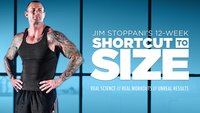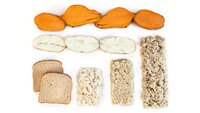
Macro Calculator: Count Your Macros Like a Pro!
Find your macronutrient ratio for flexible dieting and "if it fits your macros." Build a meal plan around your ideal ratio of proteins, carbs, and fats!
In recent years, a dietary approach called IIFYM, or "if it fits your macros," has taken the fitness world by storm. Also known as "flexible dieting," it turns old-school, calorie-based dieting on its head by focusing instead on the amount of protein, carbohydrates, and fats making up those calories. As long as you come close to your numbers (how close remains a subject of debate), you have a lot of flexibility on what foods you can use to get there.
Sound a little advanced? It is. If you're wondering if this approach is right for you, trainer and health coach Sohee Lee provides guidance in her article,"To Macro or Not: Should You Track Your Macro Intake?" If you know you're ready to know your macros, the macro calculator below can help you determine your daily targets for three goals:
- Weight loss
- Weight gain
- Overall health and weight maintenance
You can find in-depth explanations of our preferred macros for each goal below. And if you'd like to use the calculator to determine your targets for the macros of your choice—say, you're starting a ketogenic diet and want to know how many grams of fats make up 80 percent of your calories—click Customize My Macros to dial in your personalized numbers!
Macro Calculator
Your calorie count should put you in a slight caloric deficit of around 200-600 calories, depending on your activity level. This can help you establish a consistent, sustainable pace of weight loss. Here are your next steps to lose weight:
1. Pick a workout plan.
A well-designed program is an essential part of turning hard numbers like calories into hard-body results! Here are the most popular ones from BodyFit:
2. Learn about the best fat-loss supplements.
Supplements can help you accelerate your results once you have your calories and training in place. Krissy Kendall, Ph.D., shares her recommendations in the article, "5 Ways to Up Your Fat-Loss Supplement Game."
3. Join a fitness community.
For over 10 years, members of BodySpace have been helping each other build their best bodies. Join a fitness community that's over 2 million people strong!
Your calorie count and macronutrient ratio should put you close to a level where you maintain your current weight. Along with consistent training, this can help you focus on body recomposition, or gradually burning fat and building muscle, while focusing on your health. Here are the next steps on your journey to customize your nutrition:
1. Pick a workout plan.
A well-designed program is an essential part of staying motivated and seeing results. Here are some of our most popular programs from BodyFit:
2. Learn about the best health-focused supplements.
Supplements can help you accelerate your results and support your training once you have your calories and training in place. Chris Lockwood, Ph.D., shares what to take and why in the article, "Start Here: The Most Important Supplements for Every Body."
3. Join a fitness community.
For over 10 years, members of BodySpace have been helping each other build their best bodies. Join a fitness community that's over 2 million people strong!
Your calorie count should put you in a slight caloric surplus of around 500 calories. This can help you establish a consistent, sustainable pace of weight gain. Here are your next steps to gain muscle:
1. Pick a muscle-building workout plan.
A well-designed program is an essential part of turning hard numbers like calories into hard-body results! Here are the most popular ones from BodyFit:
2. Learn about the best supplements for gaining muscle.
Supplements can help you accelerate your muscle-building results once you have your calories and training nailed. Krissy Kendall, Ph.D., shares her recommendations in the article, "8 Proven Supplements for Muscle Growth and Strength."
3. Join a fitness community.
For over 10 years, members of BodySpace have been helping each other build their best bodies. Join a fitness community that's over 2 million people strong!
/div>WHICH GOAL AND ACTIVITY LEVEL SHOULD I CHOOSE?
MAINTAIN CURRENT WEIGHT
First time tracking macros? Or not sure which goal is right for you? Then start with "maintenance." In theory, this is where you will eat the same number of calories that you burn and maintain your current weight. Many nutritionists say before you start cutting or adding calories or tweaking your macros, you should spend some time at maintenance level and get more comfortable with tracking your foods and portion sizes.
LOSE WEIGHT
If you know that you're ready to lose a few pounds and you have some experience counting calories or tracking macros, select "lose weight." This will give you a target that is usually 200-700 calories below maintenance, depending on your activity level, and a 40/40/20 macronutrient breakdown of carbs, protein, and fats. This is a popular "sweet spot," both calorically and in terms of macronutrients, for healthy, sustainable weight loss.
GAIN WEIGHT
Gaining weight—especially as muscle—sounds easy enough. Train hard, eat big, right? But once the fork hits the plate, plenty of people find they need to eat far more than they realized to see the scale move up. Selecting "gain weight" will put you 500 calories above maintenance, on a 40/30/30 macro split. If this doesn't make the scale go up after a couple of weeks, you may need to add a few hundred more calories. If eating more protein becomes too expensive or filling, you may be better off getting those calories from fats or carbs.
ACTIVITY LEVEL
This choice should reflect the amount of activity in your life based on how you exercise and how physically active your life and/or job is. Nutritional researchers agree calorie estimates should take more into account than just the amount you exercise. Here's how to figure out what's right for you:
- Sedentary: You work at a desk job and you don't do much housework, walking, or exercising.
- Lightly active: You don't exercise much, but you go for walks 1-3 times per week and are on your feet doing housework during some of the day.
- Moderately active: You exercise 3-5 times a week and stay moving throughout the day with non-exercise activities.
- Very active: You exercise intensely or play vigorous sports on most days.
- Extra active: You exercise intensely or play vigorous sports nearly every day, including occasional "two a days." You also work a physical job or are on your feet most of the time.
SHOULD I TRACK MY MACROS?
Not everybody needs to track their macronutrient intake. But plenty of people find that as their fitness and physique goals get more specific, dialing in their nutrition in this way helps them fuel their training and achieve better results. According to one expert, it can be helpful even if it's just a temporary experiment:
"I think everybody would benefit from tracking macros for at least a 3-6-month period of their life," recommends Dr. Bill Campbell director of the Performance & Physique Enhancement Laboratory at the University of South Florida, in an episode of the Bodybuilding.com Podcast. "You just learn so much about making food choices, about overeating, undereating, and hunger. Someone might not change their behavior, but they'll know, 'Oh, that doughnut is a lot different than that chicken sandwich.' Even though the calories may be the same."
Episode 33: The Science of Physique Enhancement With Dr. Bill Campbell. Researcher and "Physique Scientist" Dr. Bill Campbell, the head of the Physique Enhancement Laboratory at the University of South Florida, talks about two groundbreaking studies he's worked on regarding protein intake for women and flexible dieting, as well as the incredible science of strength training for fat loss.
Publish Date: Monday, December 11, 2017
Considering Tracking Your Macros? Learn the Essentials of Flexible Dieting from the Experts
DOES FLEXIBLE DIETING WORK?
A significant meta-study from 2020 concluded that the old-school model of restriction-based dieting, such as those that cut back on calories by minimizing carbs or fat, are largely ineffective for long-term, sustainable weight loss. This wasn't news to the thousands of frustrated dieters out there!
But is counting and balancing macronutrients any better? A study from 2005 comparing strict and flexible dieting found that people following a restrictive approach to dieting were more likely to have a higher BMI, reduced feelings of self-control, and more psychological stress related to weight and food intake. Chalk this up as another victory for IIFYM!
But don't think that just because a macro-based approach is "flexible," it's perfect. It has advantages and drawbacks like any other nutritional approach.

Advantages of macro-focused nutrition:
- Can be customized to athletic and fitness goals
- Helps objectively compare different meals and foods
- Reflects food quality better than calories alone
- Combats temptation to cut calories too low, or let them creep too high
- Allows flexibility for personal taste and indulgences
Disadvantages of macro-focused nutrition:
- Can be confusing to the inexperienced
- Requires weighing and portioning food
- Doesn't take micronutrients into account
- Can undervalue protein quality, fiber, and vegetables
- Food labels aren't necessarily accurate
To get the most out of this dietary approach, Campbell recommends these approaches:
- Don't make it a free-for-all. Build your diet around nutrient-rich foods, but leave room for indulgences.
- Lift weights. "If your goal is to lose weight, flexible dieting by itself can work great. But you're not going to change your body shape without resistance training. Without it, you'll just be a smaller, puffier version of yourself."
- Don't let the scale tell the whole story. "If you're gaining muscle and losing fat, your body is changing for the better—regardless of the number on the scale."
- Prioritize protein. "Do whatever works best for you with carbs and fat—I don't care. Just don't cut back on protein."
HOW DO I CALCULATE THE MACROS IN MY FOOD?
You can do this using food labels, as well as by weighing out your food on a food scale and using one of the many online nutritional databases.
Weighing food may seem like a lot of counting and not much fun, but it gets easier over time. Fitness coach Vince Del Monte says in the article, "From Here to Macros: 4 Steps to Better Nutrition" that you quickly learn to "eyeball" quantities of both calories and macronutrients after just a few weeks of practice.
Bodybuilding.com has also created visual guides to help you learn these skills:
GET SYSTEMATIC ABOUT YOUR RESULTS
Once you have your daily calorie intake, it's time to take the same kind of strategic approach to the rest of your training and nutrition. These popular calculators can help you dial in your plan!




















